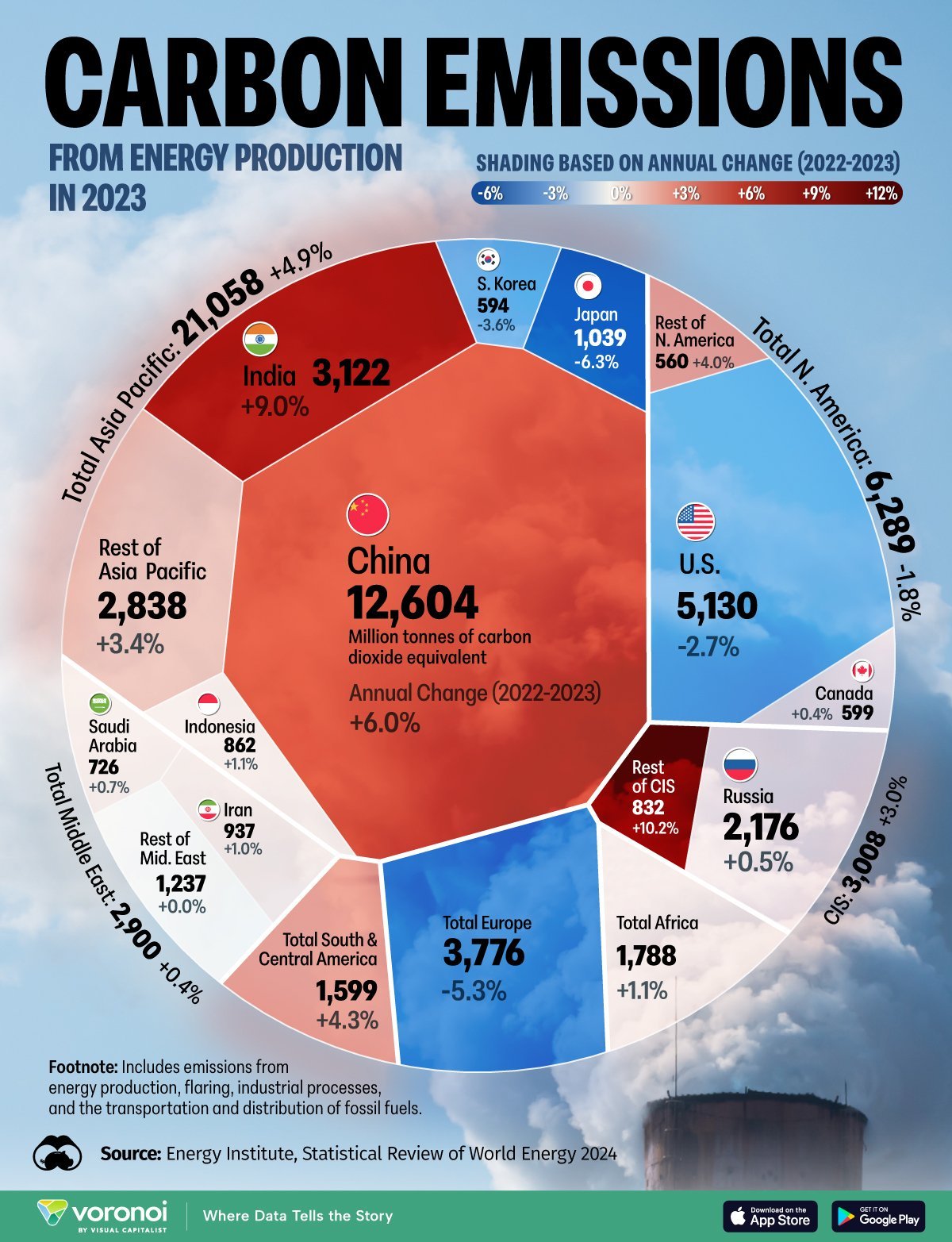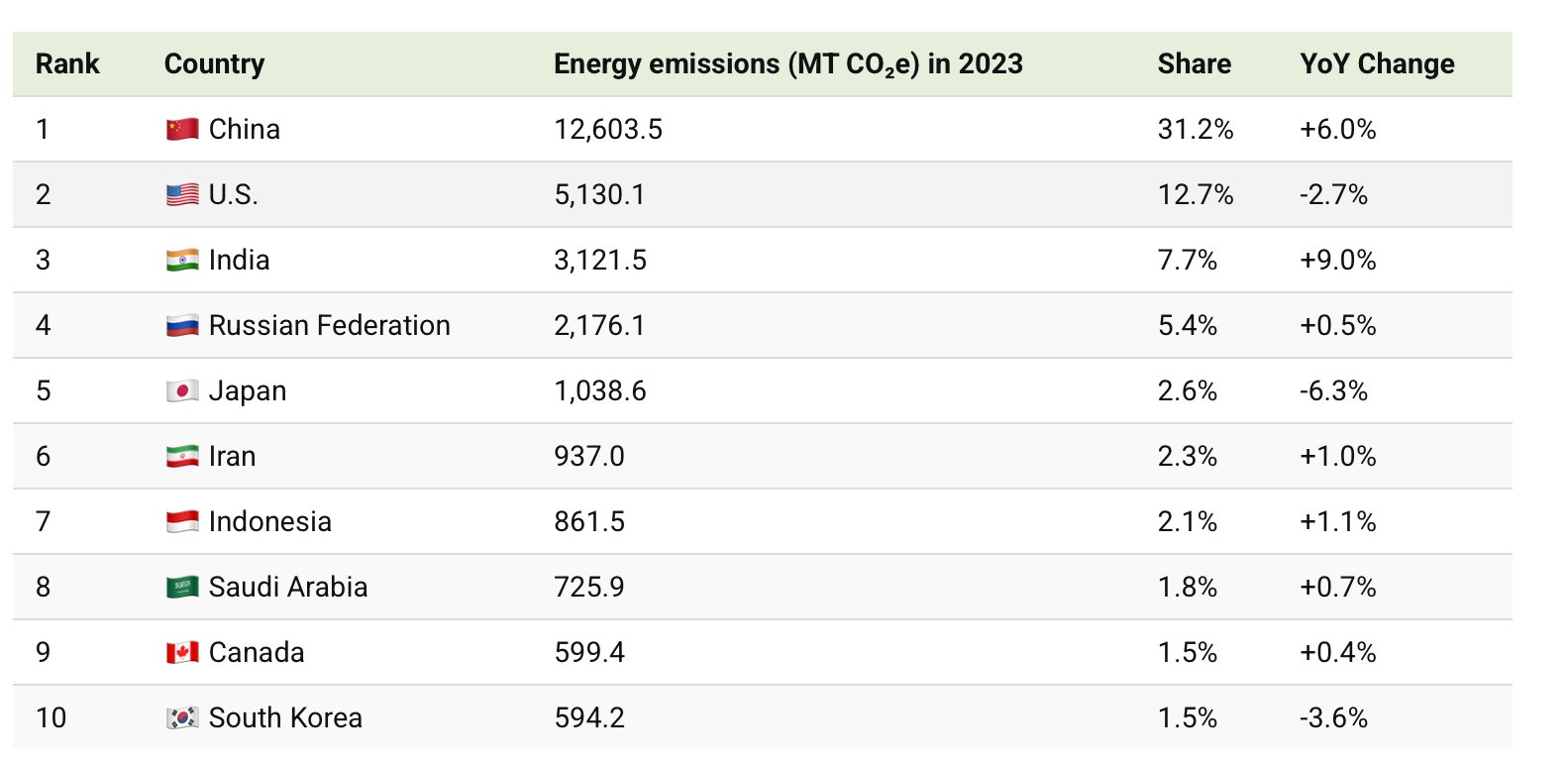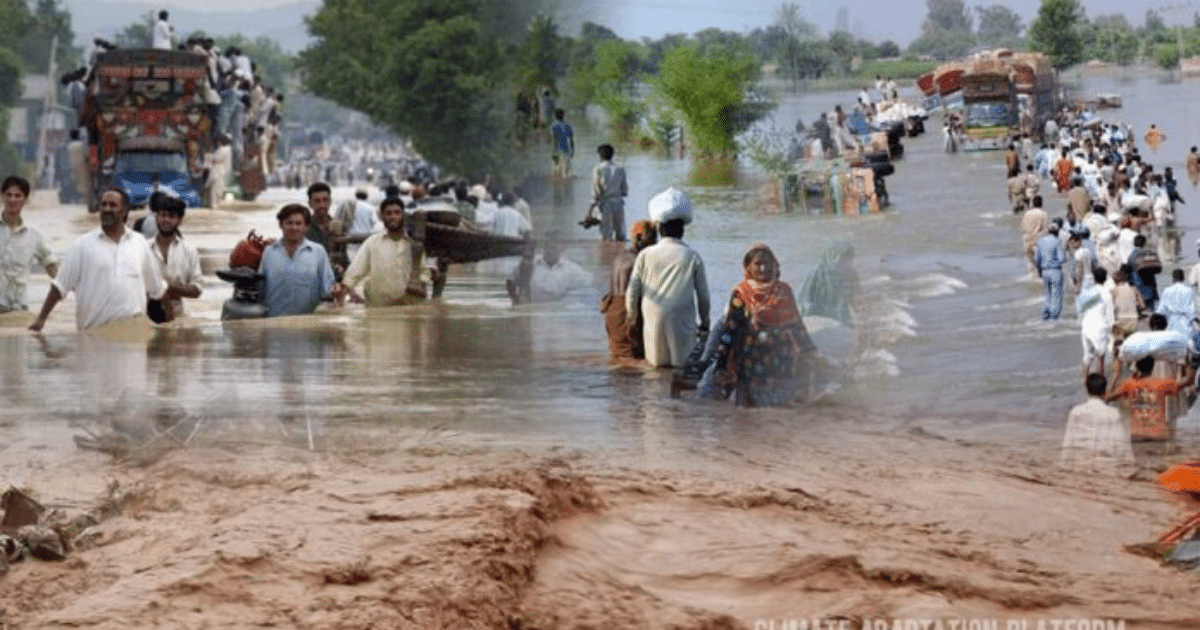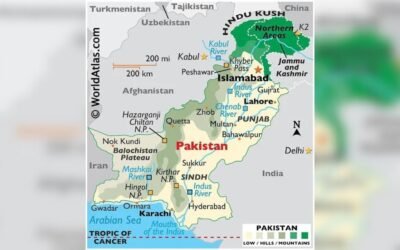While the world’s carbon giants pump poison into our shared skies, Pakistan – contributing less than 1% of global emissions – drowns in their sins. Ranked among Earth’s top climate victims, we face a cruel paradox: punished for crimes we didn’t commit. Monsoon fury now arrives like clockwork. Streets transform into rivers. Cotton fields become graveyards. Survivors wade through bureaucratic systems as slowly as floodwaters, as governments scramble with makeshift solutions. And just as the deluge recedes? India’s hydraulic stranglehold tightens. By suspending the Indus Waters Treaty, our neighbor weaponizes the rains – withholding flood data while controlling the taps to our lifeline. The result? Cities paralyzed, Crops obliterated, Communities shattered. An entire economy gasping underwater. Climate change isn’t just our crisis – it’s our Goliath. And against this monstrous foe of foreign making, Pakistan needs more than a slingshot. We need global justice.

Source: Visual Capitalist

Source: Our World in Data 
Source: Visual Capitalisist
Why Pakistan
“Pakistan is being punished for a crime it did not commit. The emitters evade accountability; the vulnerable pay in lives.”
— Malik Amin Aslam, ex-Minister for Climate Change, Pakistan

Despite making up less than 1% of global emissions, Pakistan is extremely vulnerable to climate change due to a combination of geopolitical, socioeconomic, and geographic factors. Geography & Hydrology – “A Perfect Storm”. Pakistan is blessed with more glaciers (7,532) than anywhere outside the poles. Rising temperatures (2 times the global average) causes simultaneous flooding and droughts – accelerated melting triggers Glacial Lake Outburst Flood; like 2022’s devastating outburst and recent flooding while long-term glacier shrinkage threatens the Indus River System that waters 80% of Pakistan’s farmlands. In addition to glacial time-bomb there is an additional factor of monsoon trap. Warming Arabian sea injects 50% more moisture into monsoons (PMD). Rain now dumps in concentrated bursts (e.g., 2025: 450mm in 72 hours in Karachi) rather than evenly. Combined with flat topography (40% of Pakistan is <300m elevation), this turns the Indus Basin into a slow-draining bathtub. The same regions swing between biblical floods (2022) and drought (2023-24 Thar Desert). Soil moisture evaporates faster in heatwaves (>50°C), creating concrete-like ground that can’t absorb sudden rain.
Possible Effects of the Indus Water Treaty (IWT)
India’s unilateral decision to hold the Indus Water Treaty in abeyance can have multiple repercussions for Pakistan vis-à-vis floods. Although stopping the water of the Indus River is a far-fetched idea for India, considering the mammoth infrastructure and time required to build it. IWT mandates the real-time sharing of data on river flows (e.g., rainfall, reservoir levels) between India and Pakistan. Without this data, Pakistan’s flood forecasting accuracy can drop by 50–70% (World Bank). Unannounced water releases from Indian dams (like Harike on Sutlej/Ravi) could trigger sudden flash floods in Punjab, replicating 2025’s chaos. India, furthermore, plans to construct 10+ dams on Western rivers, which can worry stakeholders in Pakistan. Withholding water in non-monsoon months exacerbates drought, resulting in parched soil that reduces absorption capacity and may exacerbate flood damage later. IWT suspension halts sharing of glacial melt/surge alerts from Indian Illegally Occupied Jammu and Kashmir. Pakistan’s 7,000+ glaciers face increased GLOF risks (glacial lake outburst floods,) which can trigger a major GLOF (e.g., at Shisper Glacier) with zero warnin,g resulting in mass floods in Gilgit-Baltistan. What remains to be seen is whether India can withstand the global pressure if it attempts to halt the flow of water from these Western rivers. Given the recent lack of diplomatic support India elicited during Operation Sindoor and overwhelming support received by Pakistan during Operation Bunyan Mursoos, India would need to recalibrate its strategy vis-a-vis IWT.
When Water Becomes an Agent of Chaos
Floods bring devastation in more ways than imaginable. They have long and short-term effects, which must be identified to be dealt with effectively.
- The immediate carnage. Pakistan is expected to lose more than $20 billion due to floods, with roads, bridges, and over 4.5 million acres of crops destroyed. In Karachi, the export hubs remained submerged, resulting in nearly $3 billion in lost trade.
- The recent flood situation has become a humanitarian disaster, with hundreds dead, more than 10,000 injured, and millions displaced. This has led to a surge in cholera cases in Sindh and dengue in Punjab. Healthcare facilities are overwhelmed, placing a significant strain on the healthcare sector.
- Recent floods have caused severe damage to Pakistan’s agricultural exports, including sugar, cotton, and rice. Furthermore, wheat shortfalls are expected to exceed 3 million tons, which could lead to a 70% increase in wheat prices. The cumulative effect may push more than 30% of rural families into the hunger red zone.
The Long Shadow (Systematic Long-Term Impacts)
Economic Scarring. Pakistan’s GDP growth has taken a hit, with the SBP projecting only 0.5% growth for 2026-2027. This may lead to a looming debt with the IMF, resulting in further budget cuts for other sectors. Floods are also erasing 2 million jobs – mostly farmers, small vendors, and women textile workers. With youth ready to enter a job market with 40% unemployment, floods will further worsen the situation.
You May Like To Read: Why More Women Are Entering Politics—And Winning
Climate Trauma Cycle. Floods exacerbate saltwater intrusion and cause permanent desertification, while the accelerated Himalayan ice loss leads to less dry-season water and more GLOF bombs.
Social Fabric Unraveling. Thousands of displaced people have fled to urban centres looking for shelter. This will create another imbalance in the rural-urban life balance, potentially leading to ethnic strife. Moreover, millions of children missed school, while child labour is expected to rise more than 15%.
More Than Floods: Diverse Outcomes of Climate Change
“We work or starve. Last summer, I carried bricks till I fainted – my kids still went hungry.” — Riaz Ahmed, construction worker, Karachi
2025 saw Punjab/ Sindh hit 52°C (126°F), collapsing power grids and killing many (mainly labourers, elderly). Heat wave collapsed 70% daily wages for outdoor workers (farms, construction). Productivity also dropped 40% in Lahore factories. Karachi’s concrete sprawl traps heat, resulting in nighttime temperatures that remain at 38°C, denying any respite to an exhausted workforce.
Glacial Melt; Floods Today Thirst Tomorrow.
Three thousand forty-four glacial lakes now threaten outbursts. The 2025 Shisper GLOF affected two villages in Gilgit. Meanwhile, the Indus Basin, which relies on glaciers for 40% of its water melt rates, has seen rates increase by up to 65% since 2000, leading to both short-term floods and long-term droughts. Climate change may also create a Hydroelectric Crisis – Tarbela Dam’s reservoir life cut by 25 years due to sediment from accelerated melt.
Agricultural Apocalypse: Beyond Flooded Fields. Wheat yields fell 20% in 2024 – 2025 as heatwaves during flowering killed pollen. Warmer winters invite locust swarms, which destroyed 60% of Balochistan’s orchards in 2024. Moreover, Pakistan’s cotton production has halved since 2018, resulting in a $4 billion annual decrease in textiles exports. In addition, rising sea levels, combined with irrigation errors, have led to 30% of Sindh’s soil now being too salty for crops.
Coastal Drowning: The Sea Eats the Shore. The Indus Delta is retreating by 1.5 meters annually, leading to the loss of 1.2 million acres of farmland to saltwater. 70% of mangrove forests have been degraded, resulting in a weakened storm buffer. Climate change has also impacted fisheries, with shrimp catches decreasing by more than 50%.
Disease Epidemics: Climate as a Vector Dengue has surged 500% since 2000 in Punjab, while warmer weather has enabled malaria to reach the foothills of the Himalaya. (Swat Valley saw its first cases in 2024). Heat-stunted crops have led to 45% of Pakistani children at risk of chronic malnutrition.
Pakistan’s Climate Survival Blueprint: Action, Investment & Diplomatic Mobilisation
You May Like To Read: Pakistan and the Fallout of the U.S. Withdrawal from Afghanistan
Domestic Action Plan: Building Climate Resilience
Water Security Revolution. Pakistan needs a mega investment in water security. The Diamer-Bhasha dam must be completed by 2030 at all costs. A water emergency needs to be declared to build at least five new water reservoirs in flood-prone corridors. It will not only increase our water storage capacity but also give us the much-needed lifeline.
Smart Irrigation Policy. Pakistan is in dire need of a smart irrigation policy/drip irrigation system. It can save at least 40% of Pakistan’s water if 50% of Punjab and Sindh adopt the smart irrigation policy.
Urban Climate Proofing. Pakistan needs initiatives like Sponge Cities with permeable pavements that can recharge groundwater by 30%. Urban centers should have underground storage tanks. Civil administrations in cities like Karachi and Lahore, where high-rise buildings are prevalent, should enforce the implementation of mandatory rooftop gardens. Urban forests should be reintroduced with strict penalties for any damage or cutting of trees. This is a survival imperative for Pakistan in the coming decades.
Nature-Based Solutions. Implement the Green Pakistan Initiative wholeheartedly. Reforest the banks of the Indus River to reduce erosion. Restoring mangrove forests along the Sindh coast will help prevent storm surges and flash floods. Installing early warning systems in GB glaciers will help save human lives.
Where to Invest: Priority Sectors.
- 40% – Water / Flood Management. On dams, canal upgrades, and AI flood modelling.
- 25% – Green Energy. On Solar Parks (Thar Desert), micro-hydro in the mountains.
- 20% Agro-Resilience. On climate, seeds, soil health, and agriculture labs.
- 15% Health / Adaptation. Heatstroke centres, mobile dengue clinics.
1. Diplomatic Offensive: Demanding Climate Justice
Why should the International Community Care? Pakistan’s climate crisis is a global systemic risk. If 250 million people face collapsing food systems, mass displacement will ignite regional instability. Climate refugees could overwhelm borders from Delhi to Dubai. Water wars over the Indus could destabilise a nuclear-armed region. Moreover, Pakistan’s $411B economy—woven into global textile and food chains—will drag down worldwide trade. But beyond pragmatism, there’s morality: the G20 nations are responsible for 80% of emissions, while Pakistan suffers the 9th highest climate-related losses. Letting Pakistan drown isn’t just myopic—it’s a crime of climate injustice.
Legal Action on IWT. India has taken a unilateral step by putting IWT on hold, which is a treaty brokered by the World Bank, an international organization. The Ministry of Foreign Affairs should file a petition with the World Bank to enforce treaty arbitration. Additionally, Pakistan should file a case with the ICJ accusing India of “climate aggression” through a data blackout.
Regional Coalitions. Pakistan should leverage existing regional alliances and establish a new “Climate-Himalayan Alliance” with China, Nepal, and Bhutan to pressure India regionally to share glacial data. This alliance can also put pressure on India to ban upstream dams without the consent of low-lying countries. Pakistan should also leverage CPEC with China to put additional pressure on India to halt dam construction and resume data sharing.
Global Financial Justice. Pakistan is a victim of massive carbon emissions by the G20 nations. We must demand at least $16 Bn per year for the next 10 years as Loss & Damage Funds Payouts, considering the losses that occurred in 2025. IMF must be persuaded to suspend repayments during disaster years. It can be termed as climate debt relief.
UN Leadership. Pakistan must propose a UN Resolution “Climate Disasters as Triggers for Arms Embargoes” against emitter nations refusing aid. Pakistan has a seat on the Security Council till December 2026, which must be utilised as a voice for climate-vulnerable states.
You May Like To Read: Pakistan’s Border Management Strategy: Are Biometric Fences Enough?
Timeline for Survival – Critical Actions
Immediate (2025 – 2026). Pass the National Climate Emergency Act and pursue securing $10 Bn as the Loss and Damage Fund.
Medium Term (2027 – 2030). Achieve 50% renewable energy. Resolve the IWT dispute with India through the World Bank and the ICJ. Make new alliances functional. Ensure implementation of Urban Climate Proofing. Ensure Central Park in every city, society, and new construction scheme. Implement the concept of rooftop gardens in letter and spirit: Mangrove Forests and Plantation of the Indus basin.
Long Term (2030 ahead). The Indus basin was declared a UNESCO “Climate Heritage Zone”. Achieve 75% clean energy.
The Stakes: A Final Warning.
Pakistan stands at a precipice. Without these steps, we face 50 million climate refugees by 2040, permanent agricultural collapse in the Indus Valley, and GDP losses exceeding $ 500 billion. However, if the world acts—and Pakistan leads—this crisis can give rise to a model of resilience. We’re demanding justice. The carbon titans have damaged our climate; they must compensate for the damage.







